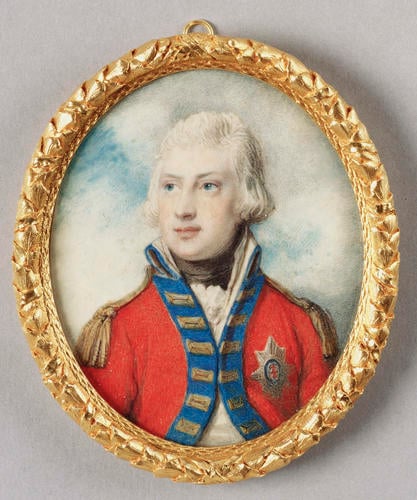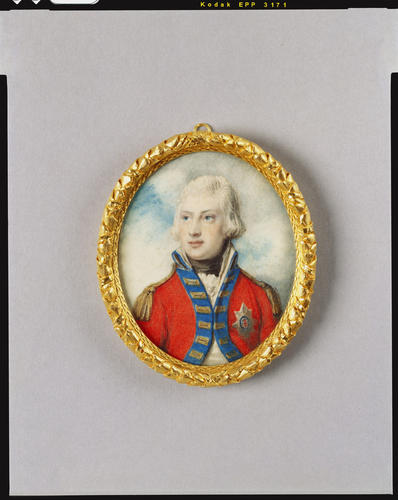Adolphus, Duke of Cambridge (1774-1850) 1793?
Watercolour on ivory | 8.5 x 7.1 cm (sight) (sight) | RCIN 420785
-
Prince Adolphus is wearing the uniform of Colonel of the 1st Regiment of Hanoverian Guards, and the star of the Order of the Garter. He was the 10th child and seventh son of George III and Queen Charlotte. At the age of 12, he was sent, with two of his brothers, to university in Göttingen. He joined the Hanoverian Guards in 1790 at the age of 16. When Britain went to war with revolutionary France, Prince Adolphus was appointed Colonel in the Hanoverian army and this miniature may celebrate the occasion. In the summer of 1793, he fought in Flanders, under the command of his brother Frederick, Duke of York. He was wounded in the shoulder and captured, but rescued in a raid by British infantrymen. His good looks, courteous manners, and sensitivity to music and the arts ensured his popularity at court and he was the King's and Queen's favourite son. In 1818, he married Princess Augusta Wilhelmina Louisa (1797–1889), third daughter of Frederick, Landgrave of Hesse-Cassel, and Caroline Polyxena of Nassau-Usingen. They had three children.
Richard Cosway (1742-1821) was born in Devon, the son of the headmaster of Blundell's school, Tiverton. The family were prosperous, and owned a woollen business and property. At the age of 12, Richard was sent to London to study drawing under Thomas Hudson at Shipley's drawing school. He entered the Royal Academy Schools in 1769 and exhibited at the Royal Academy between 1770 and 1806. He married Maria Hadfield in 1781, an accomplished artist herself. The couple had one daughter, who died at the age of seven. Richard Cosway's portrait of Maria Fitzherbert attracted the attention of the Prince of Wales who appointed him as his official miniature painter in 1786 and general advisor for the decoration of Carlton House, his residence in London. In 1811, however, Cosway lost the Prince's favour and his eyesight began to fail. He was eccentric and outlandish in behaviour and dress, but was an astute collector and acquired a fine collection of old master drawings. His miniatures are painted with a delicacy and fine modelling, and he developed the technique of using transparent pigments which allows the natural luminosity of the ivory to shine through.
Inscribed on the backing card in nineteenth-century handwriting in pencil: Duke of Kent by Cosway.Provenance
Probably commissioned by George IV when Prince of Wales (30gns); first certainly identifable in the Royal Collection in 1870
-
Creator(s)
-
Medium and techniques
Watercolour on ivory
Measurements
8.5 x 7.1 cm (sight) (sight)
10.0 x 8.6 cm (frame, external)
Category
Object type(s)
Other number(s)
Cust 1910 : Cust, L., 1910. Windsor Castle: Portrait Miniatures, London – Cust 1910 III/174RL 1870 10.A.4Alternative title(s)
Edward, Duke of Kent (1767-1820), previously identified as









